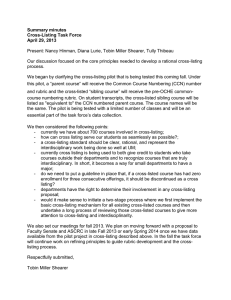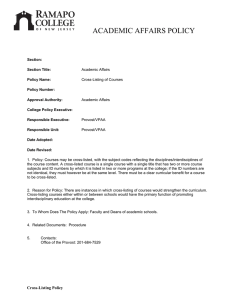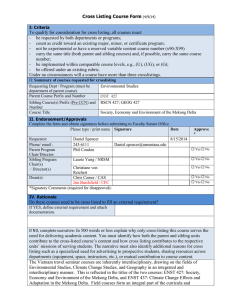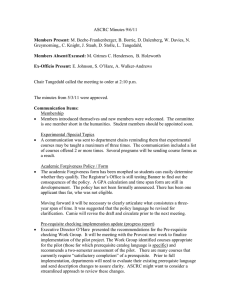ARC Report to Faculty Assembly November 2010 Summary of Current Activities
advertisement
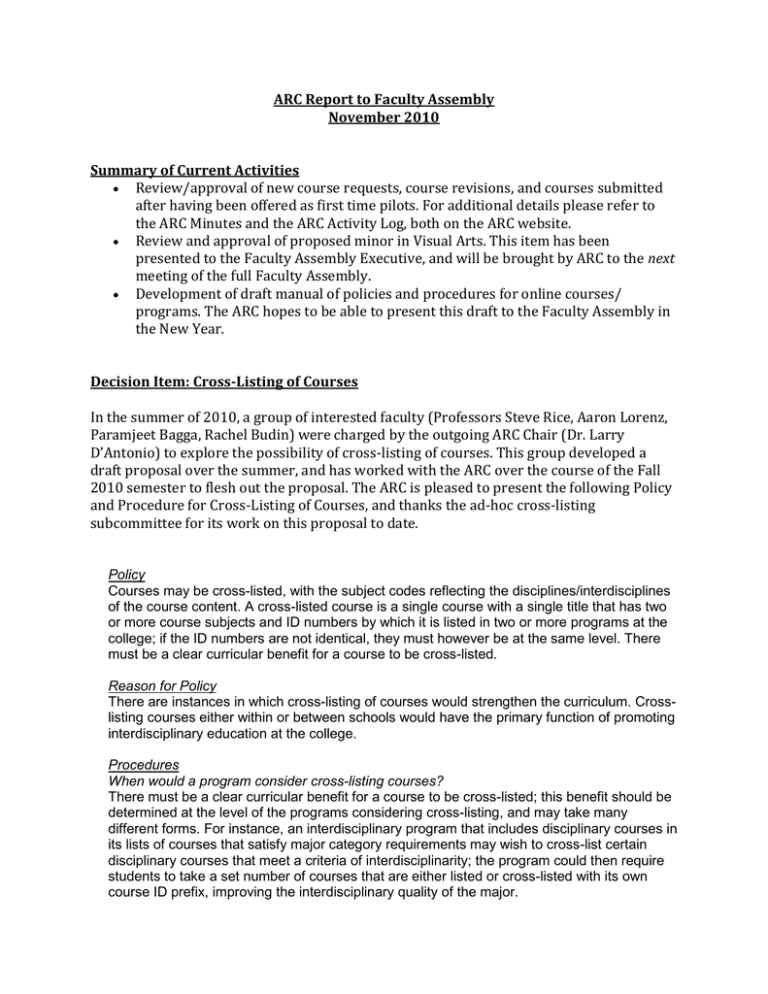
ARC Report to Faculty Assembly November 2010 Summary of Current Activities Review/approval of new course requests, course revisions, and courses submitted after having been offered as first time pilots. For additional details please refer to the ARC Minutes and the ARC Activity Log, both on the ARC website. Review and approval of proposed minor in Visual Arts. This item has been presented to the Faculty Assembly Executive, and will be brought by ARC to the next meeting of the full Faculty Assembly. Development of draft manual of policies and procedures for online courses/ programs. The ARC hopes to be able to present this draft to the Faculty Assembly in the New Year. Decision Item: Cross-Listing of Courses In the summer of 2010, a group of interested faculty (Professors Steve Rice, Aaron Lorenz, Paramjeet Bagga, Rachel Budin) were charged by the outgoing ARC Chair (Dr. Larry D’Antonio) to explore the possibility of cross-listing of courses. This group developed a draft proposal over the summer, and has worked with the ARC over the course of the Fall 2010 semester to flesh out the proposal. The ARC is pleased to present the following Policy and Procedure for Cross-Listing of Courses, and thanks the ad-hoc cross-listing subcommittee for its work on this proposal to date. Policy Courses may be cross-listed, with the subject codes reflecting the disciplines/interdisciplines of the course content. A cross-listed course is a single course with a single title that has two or more course subjects and ID numbers by which it is listed in two or more programs at the college; if the ID numbers are not identical, they must however be at the same level. There must be a clear curricular benefit for a course to be cross-listed. Reason for Policy There are instances in which cross-listing of courses would strengthen the curriculum. Crosslisting courses either within or between schools would have the primary function of promoting interdisciplinary education at the college. Procedures When would a program consider cross-listing courses? There must be a clear curricular benefit for a course to be cross-listed; this benefit should be determined at the level of the programs considering cross-listing, and may take many different forms. For instance, an interdisciplinary program that includes disciplinary courses in its lists of courses that satisfy major category requirements may wish to cross-list certain disciplinary courses that meet a criteria of interdisciplinarity; the program could then require students to take a set number of courses that are either listed or cross-listed with its own course ID prefix, improving the interdisciplinary quality of the major. Additional factors and requirements for cross-listed courses A course may be cross-listed between or among programs in the same school or in different schools and could occur within either undergraduate or graduate programs. A cross-listed course must have a primary home in one program which will be responsible for scheduling, staffing, and assessing the course. A cross-listed course cannot be offered without approval of the program in which it is primarily housed. If a cross-listed course is a requirement for its secondary program then that program must be notified of any modifications to the course so that it can determine if crosslisting should continue. A cross-listed course may be taught in multiple sections as long as the course content and learning outcomes for all sections are the same. All pre-requisites for a course remain in place for all students taking that course when it is cross-listed. The subject codes for the course ID numbers should reflect the course content. A student will receive credit only once for taking a cross-listed course and cannot switch from one course ID to the other after the add/drop period has ended. An independent study or “Topics” course cannot be cross-listed. Procedure For a course to be cross-listed (or to be un-crosslisted) it must be reviewed and approved as follows: o The convening group of each program concerned, in agreement with all instructors of the course, reviews and approves the cross-listing. o The unit curriculum committee of each unit concerned reviews and approves the cross-listing. o The dean of each unit concerned reviews and approves the cross-listing. o The Academic Review Committee (ARC) reviews and approves the crosslisting. With ARC approval the notification go out to the provost’s office, the registrar’s office, and any other office responsible for administering the curriculum. The catalog description for each cross-listed "section" will include a statement identifying the course as cross-listed, and providing the course identity of the crosslisted version of the course. Course syllabi will reflect the cross-listed nature of the course (listing both identities of the course), and will include a statement that "students should ensure they are registered in the correct "section" before the end of add-drop, because no changes can be made to a student's registration after that date". Course capacities for each "section" will be managed by the faculty member teaching the course. Faculty need to be aware that granting an override in one "section" will, in effect, increase the overall capacity of the course - the other "section" will not have its capacity decreased correspondingly. Motion Accept the proposed cross-listing policy and procedures. Respectfully submitted by Emma Rainforth, ARC Chair erainfor@ramapo.edu

